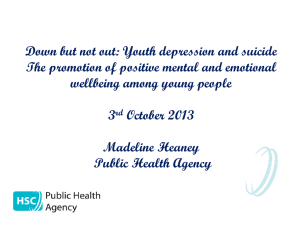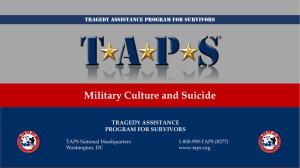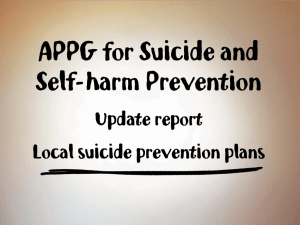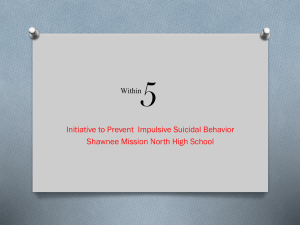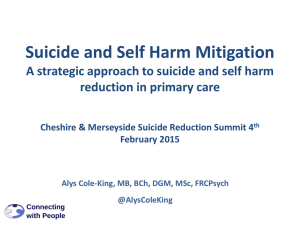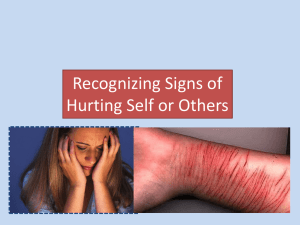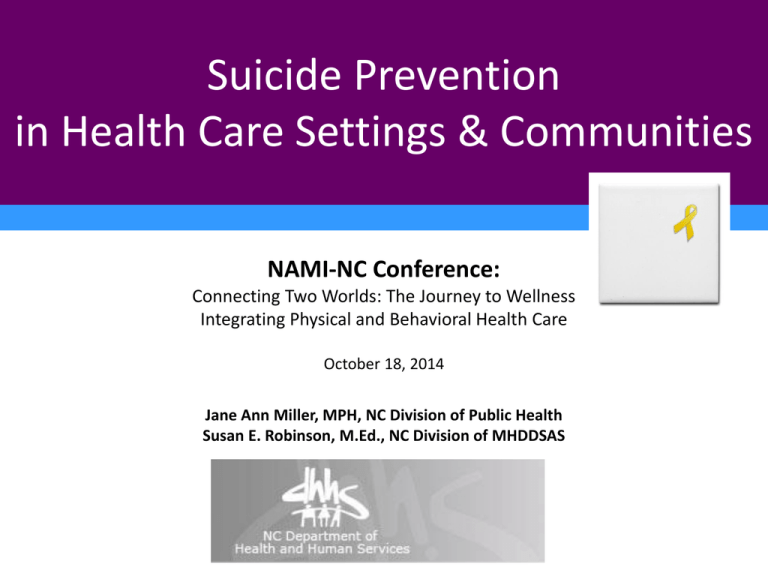
Suicide Prevention
in Health Care Settings & Communities
NAMI-NC Conference:
Connecting Two Worlds: The Journey to Wellness
Integrating Physical and Behavioral Health Care
October 18, 2014
Jane Ann Miller, MPH, NC Division of Public Health
Susan E. Robinson, M.Ed., NC Division of MHDDSAS
Dedication
To those:
who have lost their lives by suicide,
who struggle with thoughts of suicide,
who have made an attempt on their lives,
caring for someone who struggles,
left behind after a death by suicide,
in recovery, and
To all those who work tirelessly to prevent suicide and suicide
attempts in our nation.
We believe that we can and we will make a difference.
Common Understanding
• Suicide is best understood as a very complex
human behavior, with no single determining
cause.
• Suicide is a cause of death.
• Suicide is preventable.
• Future deaths are avoidable.
• Impacts lives
• Intervention and support is effective
Goals for today:
• Understand data supporting prevention
• Learn about suicide prevention programs
• Gain knowledge about state & national resources
Suicide and Self-Inflicted Injury
in North Carolina
Data Sources: Suicide and Self-Inflicted Injury
• North Carolina Violent Death Reporting System (NC-VDRS)
• Death Certificate
• Law Enforcement Reports
• Medical Examiner
• Hospital Discharge
• Emergency Department Admissions
• NC-DETECT
Suicide Deaths, Hospitalizations and ED visits
Rate of Suicides (2009-2011),
Self-Inflicted Injury Hospitalizations (2009-2011) and Self-Inflicted
Injury ED Visits (2009-2012)
for Ages 10 or Older in North Carolina by Gender
Suicides
Hospitalizations
ED Visits
Crude Rate per 100,000
140
129.5
120
102.1
91.6
100
80
67.3
60
40
22.9
20
6.2
0
Male
Female
Suicide Deaths, Hospitalizations and ED visits
240
Suicides
210
Hospitalizations
180
ED Visits
150
120
90
60
30
Age Group (Years)
+
85
75
-84
65
-74
55
-64
45
-54
35
-44
25
-34
20
-24
15
-19
0
10
-14
Crude Rate per 100,000
Rate of Suicides (2009-2011),
Self-Inflicted Injury Hospitalizations (2009-2011) and Self-Inflicted
Injury ED Visits (2009-2012) for Ages 10 or Older
in North Carolina by Age
Suicide Deaths, Hospitalizations and ED visits
Male Rate of Suicides (2009-2011), Self-Inflicted Injury
Hospitalizations (2009-2011) and Self-Inflicted Injury ED Visits
(2009-2012) for Ages 10 or Older
in North Carolina by Age
Suicides
Hospitalizations
Em ergency Visits
200
150
100
50
Age Group (Years)
+
85
75
-84
65
-74
55
-64
45
-54
35
-44
25
-34
20
-24
15
-19
0
10
-14
Crude Rate per 100,000
250
Suicide Deaths, Hospitalizations and ED visits
Female Rate of Suicides (2009-2011), Self-Inflicted Injury
Hospitalizations (2009-2011) and Self-Inflicted Injury ED Visits
(2009-2012) for Ages 10 or Older
in North Carolina by Age
Suicides
Hospitalizations
Em ergency Visits
250.0
200.0
150.0
100.0
50.0
20
-24
25
-34
35
-44
45
-54
55
-64
65
-74
75
-84
85
+
15
-19
0.0
10
-14
Crude Rate per 100,000
300.0
Age Group (Years)
Map of Suicide Rates for Age 10 or Older by North Carolina County
of Residence (2009-2011)
Map of Self-inflicted Injury Hospitalization Rates for Age 10 or Older
by North Carolina County of Residence (2009-2011)
Map of Self-inflicted Injury ED Visit Rates for Age 10 or Older by North
Carolina County of Residence (2009-2011)
Hospitalization and ED
post-discharge risk
From Inpatient Settings
• 55% of post-inpatient discharge suicides die within first week
(Brinkley et al. 2013)
From ED’s
Experience and research indicate people are still at risk after discharge particularly in the
following 30 days.
• Over 1/3 re-attempt or die by suicide within 18 months post discharge
(Beautrais, 2003)
• Studies suggest 50% -70% of suicide attempters fail to attend treatment post-discharge
Hospital Evidence Based Suicide Prevention Programs
• Emergency Room Intervention for Adolescent Females
http://www.nrepp.samhsa.gov/ViewIntervention.aspx?id=33
• Emergency Department Means Restriction Education
target age 6-19 year olds
http://www.nrepp.samhsa.gov/ViewIntervention.aspx?id=15
• Prevention of Suicide in Primary Care Elderly: Collaborative Trial (PROSPECT)
target age 55+
http://www.nrepp.samhsa.gov/ViewIntervention.aspx?id=257
Programs cross listed in the Suicide Prevention Resource Center’s (SPRC) Best Practices Registry
http://www.sprc.org/
and the National Registry of Evidence-based Programs and Practices (NREPP)
http://www.nrepp.samhsa.gov/
Hospital Suicide Prevention Programs/ Adherence to Standards
• "Is Your Patient Suicidal?" Emergency Department Poster and Clinical Guide
http://www.sprc.org/bpr/section-III/your-patient-suicidal-emergency-department-poster-andclinical-guide
• At-Risk in the ED
one hour simulation training with avatars
http://www.sprc.org/bpr/section-III/risk-ed
•
Question, Persuade, Refer (QPR) for Nurses
3-6 hour on-line training
http://www.sprc.org/bpr/section-III/question-persuade-refer-qpr-nurses
•
Recognizing and Responding to Suicide Risk in Primary Care
One hour training
http://www.sprc.org/bpr/section-III/recognizing-and-responding-suicide-risk-primary-carerrsr%E2%80%94pc
---------------------------------------------------------------------------------Suicide Prevention Toolkit for Rural Primary Care
http://www.sprc.org/for-providers/primary-care-tool-kit?sid=37583
Approaches to Engage Discharged Patients
• Follow-up calls, emails, postcards, texts
• Mobile Apps
o ReliefLink: monitor mood, suicidal thoughts, medication and appointment
reminders, safety plan, link to crisis services
o MY3: three personal support contacts, direct connection to the National Lifeline
o mypsych
o reachz
Crisis Services Continuum
Peer Support & Respite Services
Mobile Crisis Team
Same Day Access Program
CIT Partnership
EMS Partnership
Outpatient Provider
LME-MCO Access Center
Primary Care Physician
Early
Intervention
24/7 Crisis Walk-In Clinic
Response
Hospital Emergency Dept.
MH First Aid
Non-Hospital
Psychiatric Advance Directives
Prevention Stabilization
WRAP
23 hour Observation
Facility Based Crisis
Non-hospital Detox
Person Centered Crisis Planning
Hospital Units
Community (including 3-way beds)
State Psychiatric & ADATC
Family & Community Support
Transition Supports
LME/MCO Care Coordination
Critical Time Intervention
The Crisis Solutions Coalition Priorities
• Fund, define, and monitor 24/7 Walk-in Crisis Centers as alternatives to
divert unnecessary ED visits AND as jail diversion sites for CIT officers
• Provide training and support for all involved system partners – 911
responders, EDs, Providers, Consumers and Families
• Re-work Mobile Crisis Teams
• Fund the WHOLE service continuum -- Peer Support, Case
management, Jail in-reach, EMS diversion, etc.
• More inpatient beds are needed
• Utilize our collective data
• Treat the whole person – integrated care
• Emergency Departments should still have a role and be prepared to do
so
• Focus on prevention strategies like Psychiatric Advance Directives and
MH First Aid
NC DIVISION OF MH/DD/SAS
The Crisis Solutions Initiative
… building a crisis services continuum
to match a continuum of crisis
intervention needs
For more info: Crystal Farrow
Crisis Solutions Initiative Project Manager
http://crisissolutionsnc.org/
Prevention in North Carolina
For each of us as individuals –
NC Suicide Prevention Lifeline 1-800-273-8255
Its Ok To Ask” & chat lines
Text for Teens: NAMI in partnership with MCOs (7 county pilot)
NC Youth MOVE, NAMI on Campus, Family to Family & Peer
Supports
Evidenced based and informed services and supports
Preventive health care
For family members –
LME/MCO Crisis Lines & Mobile Crisis Services
Support Groups: Prevention & Postvention
Outreach & support – consumer, youth & family organizations
Web sites: LME/MCO , state and national resources
Evidenced based and informed services and supports
Prevention
in
North
Carolina
For communities at large –
Gatekeeper Trainings
Learn signs & symptoms & ways to get help needed
Curricula Programs for Schools and Professional Groups
•
Training and Support through SAMHSA: Garrett Lee Smith
•
Mental Health First Aid Training
•
Parents and Teachers as Allies
Prevention Coalitions and Community Collaboratives
Parent Resource Centers
Positive Parenting Programs
Pro-social youth activities & leadership development
Supports for those touched by suicide
Trauma informed community engagement – “it takes a village”
Outreach to high risk groups – e.g. military, veterans & Guard
Public – private partnerships – faith, businesses, EAPs, SROs,
CITs, higher education
National & State Plans
• Everyone has a role in preventing suicides.
–
–
–
–
promote wellness
increase protective factors
reduce risk
promote effective treatment and recovery.
DHHS – public health and behavioral health work together
• Promote public dialogue, counter shame, prejudice, and silence;
• Build public support for suicide prevention – policies & systems;
• Address needs of vulnerable groups – culture & disparities;
• Coordinate and integrate health and behavioral health - continuity of
care;
• Reduce access to lethal means among individuals with identified suicide
risks; and
• Apply the most up-to-date knowledge base for suicide prevention.
NSSP & State Plan Strategic Directions
1. Create supportive safe environments that
promote healthy & empowered individuals,
families, and communities
2. Enhance clinical and community preventive
services
3. Promote availability of timely treatment &
support services
4. Improve suicide prevention surveillance
collection, research, & evaluation
DMHDDSAS works with other state
and local agencies to provide
prevention,
crisis intervention,
treatment,
recovery support and
other services to people who are
most at risk for, contemplating suicide
or who have attempted suicide, and
to their families.
National Prevention Strategy
Community Wellness, Prevention and Health Integration
• Wellness is:
* More than being free from illness or disease.
* An active process of change and growth.
* Awareness of and making choices toward healthy
and fulfilling life.
• Wellness domains interrelate with another:
Emotional
Social
Physical
Spiritual
Environmental
Intellectual
Occupational
ZeroSuicide
http://zerosuicide.actionallianceforsuicideprev
ention.org/
National Action Alliance for Suicide Prevention
Partnership of private and public organizations to enhance the goals set forth by
the National Strategy for Suicide Prevention (2012)
One of their focuses
GOAL 8: Promote suicide prevention as a core component of health care
services to include promoting “zero suicides”
What is ZERO SUICIDE?
Zero Suicide is a commitment to suicide prevention in health and behavioral health care
systems. Its core proposition is that suicide deaths for people under care are preventable
and that the bold goal of zero suicides among persons receiving care is an aspirational
challenge that health systems should accept
Zero Suicide
Step: Ensuring Every Person Has a Pathway to Care
•
Standardized suicide screening of all members enrolled in active behavioral healthcare services.
•
Formal assessment by a qualified health or medical provider for anyone screening positive for suicide risk.
•
Stratification of the risk, as indicated by the assessment, into low, medium or high risk.
•
Engagement of the patient or client in best-practice interventions geared to risk level.
•
Follow-up contact from provider or caregiver.
Step: Continuing Contact After Care
•
After a visit to a behavioral health outpatient setting or primary care, for anyone at risk.
•
Between services for those with scheduled care and to engage those not actively engaged in care.
•
After discharge from acute care settings
Prevention Partners in NC
The Jason Foundation
QUESTIONS?
NC State
UNC
Go Heels!
http://www.trianglesos.com
North Carolina
Duke
Key Resources:
•
•
•
•
•
•
•
•
•
•
•
•
•
American Association of Suicidology
American Foundation for Suicide Prevention
Center for Disease Control: Suicide
Center for Disease Control: Youth Risk Behavioral Surveillance System
Jason Foundation
The Jed Foundation
NAMI (National Alliance on Mental Illness)
National Council for Suicide Prevention
National Strategy for Suicide Prevention (PDF)
Samaritans USA
Suicide Awareness Voices of Education (SAVE)
Tennessee Suicide Prevention Network
Yellow Ribbon Suicide Prevention Program
Resources
For additional information about the National
Strategy for Suicide Prevention (NSSP), visit:
• http://www.surgeongeneral.gov/library/repor
ts/national-strategy-suicideprevention/index.html
• http://www.samhsa.gov/nssp
• http://www.actionallianceforsuicidepreventio
n.org/NSSP
SAMHSA Resources - Suicide Prevention
Providers:
• http://store.samhsa.gov/shin/content//SMA134793/SMA13-4793.pdf
Administrators:
• http://store.samhsa.gov/product/Quick-Guidefor-Administrators-Based-on-TIP-50/SMA13-4786
High schools: (tool kit)
• http://store.samhsa.gov/shin/content//SMA124669/SMA12-4669.pdf
Thank you for taking the next step…
For more information:
NC DMHDDSAS
• susan.robinson@dhhs.nc.gov
919-715-2262
NC DPH
• jane.miller@dhhs.nc.gov
919-707-5434




